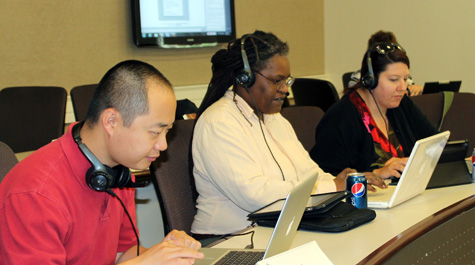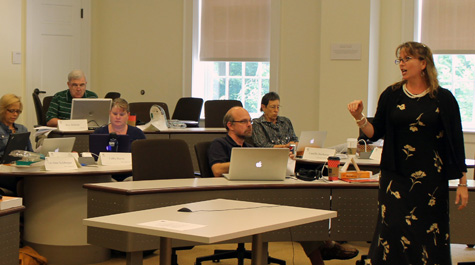Faculty learning to create blended e-learning courses
Faculty members from across the William & Mary campus are exploring blended learning this summer so that next year they can teach their own blended courses, which will combine traditional in-class instruction with technology-aided learning outside of the classroom.
Seventeen faculty members are participating in the seven-week E-learning Professional Development (ePD) course, which began in early June. The course, which is being taught by four instructors from the Mason School of Business and School of Education, was created through Provost Michael R. Halleran’s Creative Adaptation Fund.
The initiative, which began last year, seeks to find creative ways to improve the College’s educational programs either directly, or indirectly by reducing costs or generating new revenues. A $200,000 fund was established to encourage those efforts, and, in March, grants were awarded to seven of the proposed projects, including the ePD course. Faculty and administrators from Information Technology, the Mason School of Business and the School of Education submitted that grant proposal.
“I just have a sense that this is the direction that a lot of education is going,” said Karen Conner, one of the ePD’s instructors along with Judi Harris, April Lawrence and Sara Gividen. “Blended learning is what I have experienced, and I really like it because it’s a combination of face-to-face and online, so you have the best of both worlds. I thought that was really a good fit for William & Mary given what I know about the William & Mary experience.”
The goal of the course is to prepare faculty members to teach their own blended classes – either new or redesigned ones -- in 2013. Although the ePD course does include technological training, it is mainly focused on instructional topics and how the faculty members can best use technology to achieve their teaching goals.
“This course absolutely is about educational technologies, but it’s more about how you use them in instruction than the technologies themselves,” said Harris, professor of education and Pavey Family Chair in Educational Technology.
For instance, during the first week, the class looked at student-centered learning goals and what kinds of instructional activities might serve those goals. The second week, they looked at students’ learning preferences and professors’ teaching styles and how faculty members could marry the two.
“We’re really trying to focus more on instruction because that’s really what they’re doing. They’re teaching,” said Harris. “But, obviously, it’s blended, so they need to learn how to use the technologies, not only in terms of their competence with using the technologies but also how to choose which technologies to use in which ways in terms of students learning.”
Some of the technologies that the faculty members are learning about include web-meeting program Adobe Connect, blogs, screen-recording programs, wikis and even Twitter, “which a lot of the faculty didn't think could be used instructionally,” said Harris.
The class is also getting a first look at the upcoming version of Blackboard.
“We’re actually doing this on a test environment with a new service pack that will become available in August, and so far the reaction from faculty in our course has been really positive,” said Lawrence, senior academic technology specialist in the School of Education. “They like the look and feel of the updated version of Blackboard. That helps IT (Information Technology) because we are able to get in there and kind of test the environment.”
The participating faculty members – who hail from 10 different units around campus -- came into the class with a range of e-learning experience, from some who have only used Blackboard to others who have designed and taught online classes.
Lee Anne Sulzberger came into the course with a good bit of technological and online-learning experience. Now an inclusion specialist and SIM® professional developer of content enhancement routines in the School of Education’s Training & Technical Assistance Center (T/TAC), she first experienced blended learning 10 years ago and has since developed an online class for a virtual high school. She has also received certification from the Virginia Community College System to teach online courses.
Over the last few years, T/TAC has used technology to provide more flexible and accessible professional development and support to the K-12 educators that it serves, Sulzberger said.
“This course was a fantastic opportunity to learn about blended learning by experiencing it first-hand and collaborating with colleagues from many areas on campus,” said Sulzberger, who is using the course to design activities for a graduate-level elective in the School of Education on creative strategies for inclusive schools. “Everything I am learning in the ePD course will improve the e-learning options that we provide for teachers and administrators.”
Although the Creative Adaptation grant only funded one session of the ePD class, the course’s organizers hope to share information from the course with others on campus through their blog.
“We’ve added a page to the blog that we call A to Z, and we are trying to bring some of the resources that we using in this course and include links to those in the blog so that other faculty members at William & Mary who are interested in blended learning can go there and can look at different websites about instruction and technologies,” said Conner.
Though they are only a few weeks into the course, the instructors have been pleased with the positive reaction they’ve received from participants – even those who were a little “Twitter-resistant” at first. But the thing that has really impressed Lawrence about the course so far has been its collaborative spirit.
“Not just the collaboration between the business school and school of education, but also that faculty in all of these different entities from around campus can get together to talk, not only about technology but also about teaching and learning and things they are doing in the classroom,” she said.
 Skip to main content
Skip to main content


